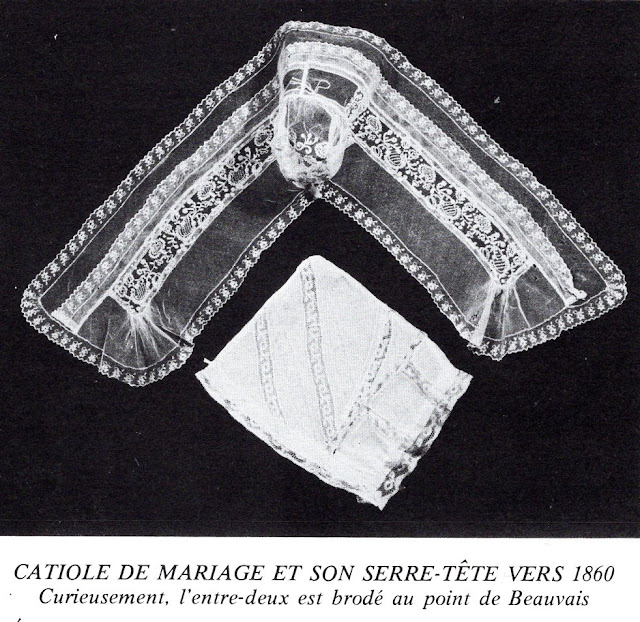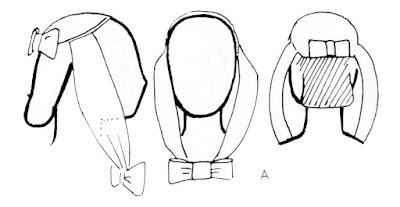Bro-Roazhon in Breton
Rennes, or Pays Rennais in French
As you can see, this costume is not only found in all of Rennes province, but was also worn in a large portion of inland St. Malo province, and in border areas of the other adjoining provinces, as well as in some detached localities in Normandy. The image at the head of the article is of this costume. Here are a couple other images.
There are three coifs associated with this region, called the catiole, the poupette, and the polka. The images above are all of the older version of the catiole, which is what performing groups usually wear today. Here are some old images of the costume.
These first two images are from Antrain.
The catiole, which resembles the original coif of much of Brittany, [and France as well], consists of two parts; the coif itself, and a cap or bonnet which is worn underneath, the serre-tête.
Here is a sequence of photographs which show how the catiole is put on.
The catiole later became made of lace, and for a while grew and became more extravagant, 'a grande cul'.
Then in the late 19th and early 20th centuries, it gradually shrank to miniscule proportions, in the later stages losing the under cap.
This is essentially the same coif, but the lappets are shorter and wider, and are not pinned to the top, but rather starched so that they stand out like wings.
The third coif is the so called polka. This is an urban style bonnet that resembles those of Brest or Goelo, but is simpler, being simply a circle of lace or tulle with ties and a bow on the rear. This is found in all the urban centers of this region.
The men dressed in a suit with cutaway jacket for dress, and a blue embroidered smock for more everyday occasions, showing influence from France and Normandy.
Just a few more images from this region.
This concludes this article of the series.
Thank you for reading, I hope that you have found this to be interesting and informative.
Roman K.
email: rkozakand@aol.com
Source Material:




















































































































Dear Roman: Thank you for another glimpse of living history! I think the embroidered tulle on these headdresses is the loveliest I have seen - one could spend a lifetime just learning to do these patterns! And the smocks! Thank you for finding those two pictures - I'm going to get some blue fabric as soon as I finish here! The material looks glazed - do you know if they used potatoe water starch as they do in Hungary?
ReplyDeleteStay safe and well and please keep up the amazing work. Charlotte in California
This is so interesting! My grandmother wore a different style. It is nice to connect with her through history.
ReplyDelete